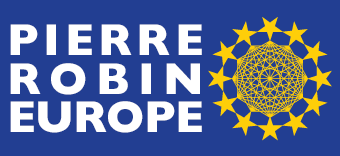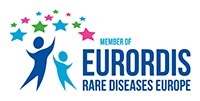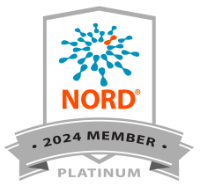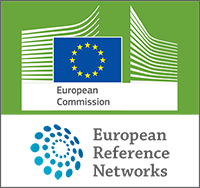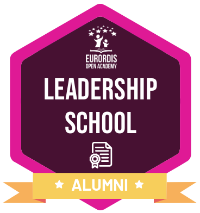Letter to Dr. Irene Mathijssen, Coordinator, ERN-Cranio, 23 November 2021
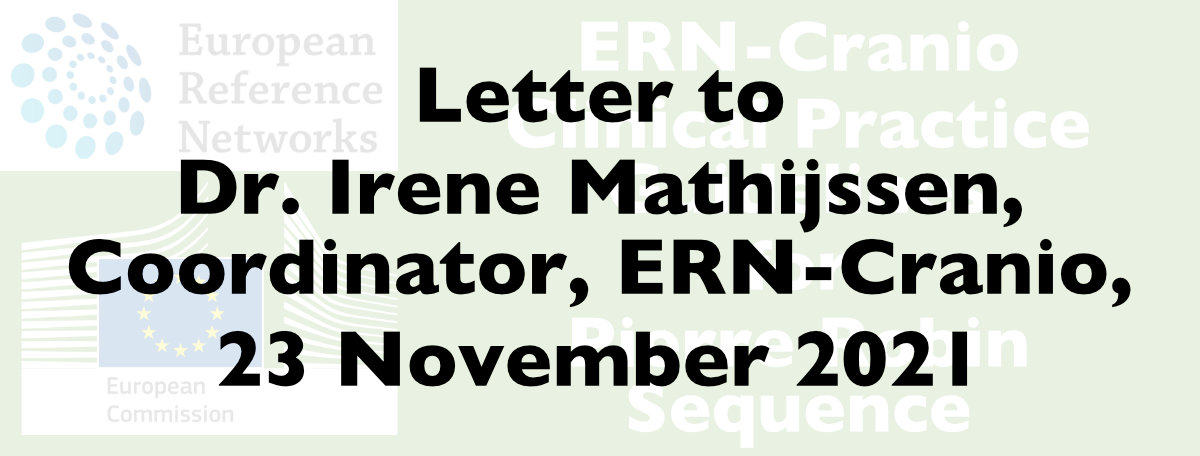
Letter to Dr. Irene Mathijssen, Coordinator, ERN-Cranio, 23 November 2021
From: Philippe Pakter, pakter@pierrerobineurope.com
Date: Tue, Nov 23, 2021 at 12:45 PM
Subject: ERN-Cranio Clinical Practice Guidelines, Pierre Robin Sequence
To: I.M.J. Mathijssen, i.mathijssen@erasmusmc.nl
CC:
Dr. Andrzej Rys, Director, European Commission Directorate-General of Health and Food Safety DG SANTE
Minister Hugo de Jonge, Dutch Ministry of Health
Yann Le Cam, CEO, EURORDIS
Neil Russell, Secretary, Stichting Pierre Robin Europe
Dear Irene,
The last time we spoke was on 21 July 2021, during a meeting to discuss the ERN-Cranio Pierre Robin Sequence Clinical Practice Guideline development project. The meeting was attended by you, ERN-Cranio Project Manager Renée de Ruiter, ERN-Cranio Project Manager Olivia Spivack, ERN-Cranio ePAG representative Gareth Davies, Inés Hernando from EURORDIS, and myself.
According to the official EU Methodology which governs the creation of ERN Clinical Practice Guidelines, it is essential that patients be included in the Guideline Development Group – not questionnaires or surveys, but patients. Therefore during the 21 July 2021 meeting I asked Renée if she had read the EU Methodology, handbook 4, governing the development of ERN Clinical Practice Guidelines. Renée responded by saying “I certainly received the extensive EU guideline book that has been developed by the European Commission.”
In the face of this vague response I repeated the same question: Renée did you read handbook 4 of the EU Methodology and if you did, when did you last read it? Renee’s answer was “I think we should at all times try to have this meeting as a constructive meeting.” It was quite clear during this July meeting that Renée had not in fact read the EU Methodology which had been distributed to all of the ERNs all the way back in February.
In fairness the EU Methodology is, as Renée said, extensive; however handbook 4, governing Clinical Practice Guidelines, is only 95 pages long. Furthermore the European Commission’s DG SANTE informed Stichting Pierre Robin Europe that ERN-Cranio received 50,000 Euros of EU funding to develop these Pierre Robin Sequence Clinical Practice Guidelines. With this level of EU funding, reading the EU rules is mandatory. Finally, if ERN-Cranio’s two Project Managers did not have time to read the EU Methodology, then ERN-Cranio could have instructed your external subcontractor Qualicura to read it, since they are receiving some portion of the 50,000 Euros of EU funds. In any of these scenarios you would have learned that when producing ERN Guidelines, patients must be in the Guideline Development Group.
On the other hand, the vital importance of including patients in the Guideline Development Group is so obvious that it is difficult for any of us, the board members of Stichting Pierre Robin Europe, to understand why ERN-Cranio felt our exclusion was somehow appropriate. We are the one and only Pierre Robin Sequence ePAG patient organization in ERN-Cranio. We have been an ePAG patient organization in ERN-Cranio since 2018. And as the organization’s chairman I published a well regarded Pierre Robin Sequence patient perspective article demonstrating extensive knowledge of this rare disease at https://doi.org/10.1016/j.siny.2021.101288
Making matters worse is the following. One of the most basic principles of Guideline development for any complex rare disease is that the best experts on that complex rare disease should be brought in and included in the Guideline Development Group. Two of Europe’s most highly respected Orphanet Centers of Expertise for Pierre Robin Sequence are the Amsterdam University Medical Center, and the Tübingen University Hospital. The volume of internationally peer-reviewed Pierre Robin Sequence medical studies which the directors of these two Orphanet Centers of Expertise have published is more extensive than any other Pierre Robin Sequence Centers of Expertise in the world. Regarding Amsterdam: the director of Amsterdam’s Pierre Robin Sequence Center of Expertise has published 29 Pierre Robin Sequence studies, an extraordinary volume of research for any rare disease. He also launched the world’s very first International Consensus Meeting on Pierre Robin Sequence. It is a confusing and painful insult to the Pierre Robin Sequence patient community to exclude from the Guideline Development group one of the most dedicated Pierre Robin Sequence experts in the entire world.
Regarding Tübingen: the director of Tübingen’s Pierre Robin Sequence Center of Expertise has published 22 Pierre Robin Sequence studies. He is currently running the world’s third International Consensus Meeting on Pierre Robin Sequence, which will take place in Tübingen in 2022. Furthermore the Tübingen University Hospital has developed a breakthrough treatment for Pierre Robin Sequence, a highly specialised, medically proven, safe, non-surgical, cost effective treatment, the Tübingen Palatal Plate. Based on its medically proven ability to safely resolve the Pierre Robin Sequence baby’s life threatening breathing difficulties – without surgery – Stanford University in America has already adopted Tübingen’s breakthrough treatment. Tübingen’s highly specialised multidisciplinary team of Pierre Robin Sequence experts provided Stanford with careful guidance, instruction and support. Now, the Tübingen University Hospital’s Pierre Robin Sequence experts are training a team at Harvard University so that they too can administer the Tübingen Palatal Plate, for babies at Harvard/Boston Children’s Hospital. The Tübingen Palatal Plate, which safely and effectively resolves the Pierre Robin Sequence baby’s breathing difficulties without the need for painful surgery, represents a breakthrough in Pierre Robin Sequence care – and yet you Irene excluded Tübingen from the Guideline Development Group. At the same time, you brought in your friends at the Great Ormond Street Hospital, which is not even in the ERN. Once again, it is a confusing and painful shock for the Pierre Robin Sequence rare disease patient community.
You say that you want to achieve the best possible care for babies with Pierre Robin Sequence. Excluding the EU’s top Pierre Robin Sequence experts from the Guideline Development Group, and excluding patients from the Guideline Development Group, will make it impossible to achieve this goal. As we have demanded since June 2021: Stichting Pierre Robin Europe should be in the Guideline Development Group – and the world-class Pierre Robin Sequence experts in Amsterdam and in Tübingen should be in the Guideline Development Group. We are open to discussing many things, but these two points are self-evident.
We have requested official intervention on the EU level and on the Dutch Ministerial level in order to bring about these reasonable requests.
Kind regards,
Philippe Pakter
Stichting Pierre Robin Europe, chairman
Member, EURORDIS, The European Organisation for Rare Diseases
Member, VSOP, Vereniging Samenwerkende Ouder-en Patiëntenorganisaties
PhD candidate, law: “Access to healthcare in Europe: the effectiveness of EU legislation in the context of rare disease patients”
